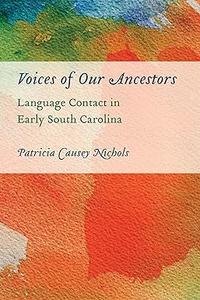
Free Download Voices of Our Ancestors: Language Contact in Early South Carolina
by Patricia Causey Nichols
English | 2022 | ISBN-10: 1643363484 | 208 Pages | ePUB | 1 MB
The first detailed linguistic history of South Carolina, with a new preface by the author
In Voices of Our Ancestors Patricia Causey Nichols offers the first detailed linguistic history of South Carolina as she explores the contacts between distinctive language cultures in the colonial and early federal eras and studies the dialects that evolved even as English became paramount in the state. As language development reflects historical development, Nichols's work also serves as a new avenue of inquiry into South Carolina's social history from the epoch of Native American primacy to the present day.
Because Charleston was among the foremost colonial American seaports, South Carolina experienced a diverse influx of cultures and languages from the onset, drawing influences from Native Americans, enslaved African Americans, and a plethora of European peoples―Scots-Irish, English, Jewish, German, and French Huguenot chief among them. Nichols tells the richly complex story of language contact from groups representing three continents and myriad cultures. In examining how South Carolinians spoke in public and private we glean much about how they developed a common culture while still honoring as best they could the heritages and tongues of their ancestors. Nichols pays particular attention to the development of the Gullah language among the coastal African American peoples and the ways in which this language―and others of South Carolina's early inhabitants―continues to influence the communication and culture of the state's current populations.
Nichols's synthetic treatment of language history makes expert use of primary source materials and is further enhanced by the author's field research with Gullah-speaking African Americans and with descendants of Native Americans, as well as her keen observation of her own European American community in South Carolina. Through her deft analysis of contemporary language variations and regional and ethnic speech communities, she advances our understanding of how diverse the South Carolina experience has been, from the lowcountry to the upcountry and all points in between, and yet how the need to communicate shared experiences and values has united the state's population with a common meaningful language in which the diverse voices of our ancestors can still be heard. In a new preface, Nichols reflects on the growing diversity of the United States as a whole and how relationships across communities shape language and culture.
